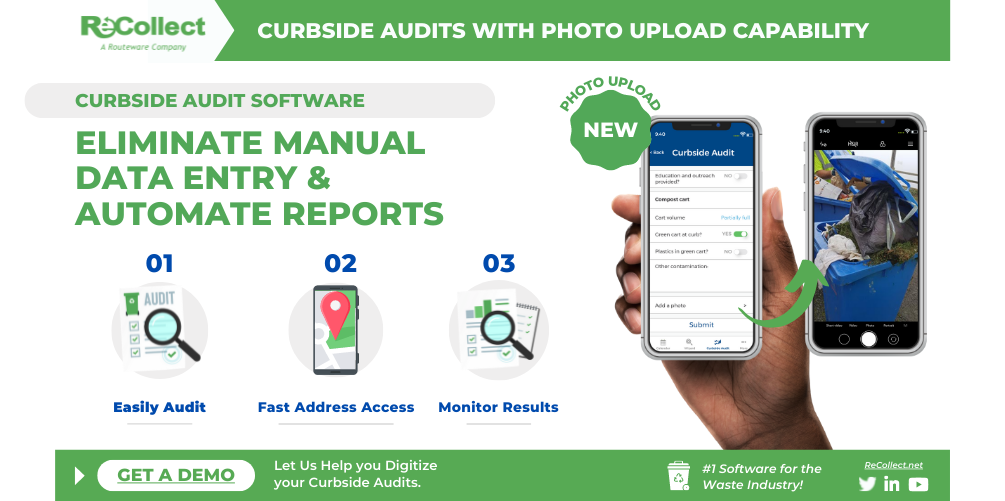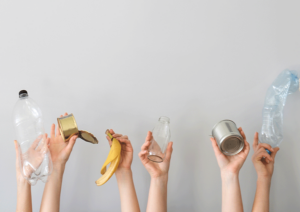Audit with Ease: Introducing the Curbside Audit Tool
In the waste and recycling industry, conducting audits might be one of the most valuable but least fun parts of our jobs. Audits can be tedious and time consuming, and if you’re operating with an inefficient system of clipboards, spreadsheets and printouts, your notes and data can be tricky to keep track of, too.
To make your life easier and improve your accuracy, record keeping and waste diversion — while saving yourself time and money too — our Curbside Audit Tool (CAT) can keep track of the information you need so that you don’t have to.
Whether you’re already running curbside audits and you’re hoping to go digital, or you’re looking to conduct a curbside audit and implement a new program, the “CAT tool enables you to do a curbside audit efficiently through digital formats,” says ReCollect Waste Solutions Manager Philip Hunter.
The customizable CAT can be tailored for commercial and residential testing alike, and can measure any metric you need, from participation rates to contamination rates. Our CAT also allows you to:
- Increase waste diversion by allowing you to easily and quickly track what people are getting wrong in their recycling.
- Lower contamination rates by helping you organize the data you need to adapt and evolve your programs, educate residents on areas that need improvement — and follow up to measure your improvement.
- Evaluate program participation by testing your existing waste and recycling program performance or pilot program and compiling the data you need.
- Reduce time in the field through an easy-to-use interface.
- Improve your reporting accuracy and make your measurements more meaningful.
- Eliminate in-office audit-related data entry by recording data directly from the field — not from back at the office.
In addition to a tailored questionnaire, Hunter says the CAT also includes a map of the evaluation area. Not only does this feature give you a layout of what data was collected from which house, but it also allows you to see the audit process in real time.
To use the CAT, auditors simply answer your study’s questions through an easy-to-navigate interface, and our tool does the rest. Each entry is immediately uploaded to your database so you may track progress and download reports.
From a data-entry standpoint, keeping track of your findings with pen and paper in the field and then later entering it into a system is fiddly and time consuming, Hunter says. Instead, with the CAT, you can easily track the information you need. “Take a photo, (and everything) automatically loads into the back-end.”
Having that photographic evidence of your findings is huge, too, and it takes record keeping to the next level, Hunter says. “You don’t have to (answer) detailed questions about contamination, just ‘Is there contamination?’ ‘How full (is the bin)?’ … (Then), take a picture. Make it bang, bang, bang, upload, go,” Hunter says.
“It just creates efficiency.”
Having the option to add a photo to your reporting also ensures you have a photographic record of the information you need to help your community make lasting changes.
“This is about compliance and actually giving your compliance program teeth,” says ReCollect’s Product Marketing Manager Tim Adkins.
On the flip side, the tool can also help you reward good recyclers in your community, too, Hunter says. “Maybe you want to give props to people who are doing it well … and reinforce their good behavior.”
As organizations everywhere such as Recycle BC push for better recycling habits and lower contamination rates, Hunter says, tools like the CAT can be “part of that plan of addressing contamination.”
The CAT is “the next step” that provides you feedback after tackling education and engagement through your campaigns, ReCollect’s Waste Wizard and Waste Sorting Game, Hunter says, and allows you to focus your messaging to fill in any gaps.
“Education — engagement like that is huge. Ideally, we can get to the better-recycling-and-less-going-to-the-landfill (goal),” Hunter says. To meet those goals, however, “at some point, we need to get in there; we need to actually see what’s happening on the ground.”
And the CAT allows you to do just that.
“It’s like taking that next step to address contamination,” Hunter says. “And there’s value in that.”
For more information, check out our CAT learning page today. Know the CAT is right for you? Let’s talk.
[/et_pb_text][/et_pb_column][/et_pb_row][/et_pb_section]




